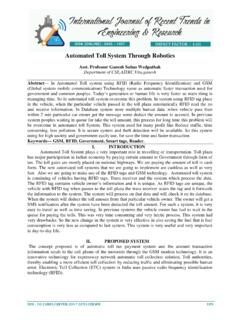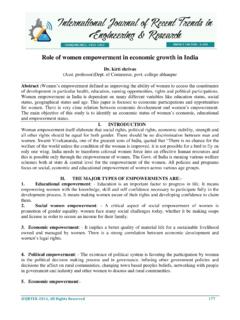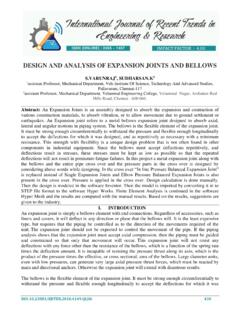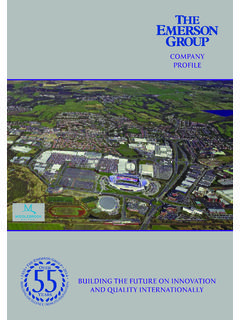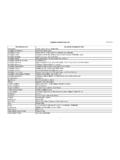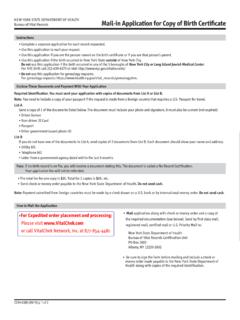Transcription of DENIM: REVOLUTION IN TEXTILE MANUFACTURING
1 @IJRTER-2016, All rights Reserved 9 DENIM: REVOLUTION IN TEXTILE MANUFACTURING Prof. (Dr.) Subhash Desai1 1 SAL Institute of Technology and Engineering Research Opp: Science City, Village Bhadaj, Ahmedabad 380 060 Abstract: In countries like UK, USA, CANADA, JAPAN and CHINA, there was introduction of denim for clothing sometime two decade ago. The popularity of this fashion ware is due to many factors such as long durability, not frequently washing, no ironing, protection against cold etc. It is observed that denim is also getting popularity in India by all age group of people like child, youth and older. In India, climate is not very cool but still preference is for denim in day to day use because it is available at affordable price.
2 Denim is the sweet gift of God for middle class family. However, higher income group families adopting it as more comfortable and fashionable dress code. People having traveling jobs and also in air conditioning offices, it is a pride of status symbol in wearing denim trousers. In this paper, let us understand the contribution by Ashima and Arvind from Gujarat and try to observe these denim giant with their standing in retail garments business. Keywords: Retail Business, Denim, Fashion. I. INTRODUCTION:[1] India TEXTILE industry largely depends upon the TEXTILE MANUFACTURING and export. It also plays a major role in the economy of the country.
3 India earns about 27% of its total foreign exchange through TEXTILE exports. Further, the TEXTILE industry of India also contributes nearly 14% of the total industrial production of the country. It also contributes around 3% to the GDP of the country. India TEXTILE industry is also the largest in the country in terms of employment generation. It not only generates jobs in its own industry, but also opens up scopes for the other ancillary sectors. India TEXTILE industry currently generates employment to more than 35 million people. It is also estimated that, the industry will generate 12 million new jobs by the year 2015.
4 India TEXTILE Industry is one of the leading TEXTILE industries in the world. Though was predominantly unorganized industry even a few years back, but the scenario started changing after the economic liberalization of Indian economy in 1991. The opening up of economy gave the much-needed thrust to the Indian TEXTILE industry, which has now successfully become one of the largest in the world. [Desai, 2009] international Journal of Recent Trends in Engineering & Research (IJRTER) Volume 02, Issue 01; January 2016 [ISSN:2455-1457] @IJRTER-2016, All rights Reserved 10 II.
5 ANALYSIS OF DATA FOR ASHIMA:[1] 0500010000150002000025000300003500040000 2005200620072008 Ashima 2005 onwards Actual performance in sales (Figures are rupees in lac) [4] [1] The operational performance of the company during the year has not been satisfactory as compared to last period both in terms of sales and operational profitability. Unfavorable and sluggish market conditions in denim division, appreciation of rupee, increase in furnace oil cost, one time payment to workers of spinning division under voluntary retirement scheme, etc., have been responsible for decline in profit of the company.
6 On a positive side, in these inflationary times company has been able to control its variable and fixed costs. The abolition of quotas has intensified competition from neighboring countries and put tremendous pressure on sales price and consequently the margins. The cotton prices have remained strong during the year and due to current liquidity constraints the company could not take any long term position on cotton procurement. Company has closed down its spinning activities of shirting division and workers have been offered voluntary retirement scheme with an approximate outflow of lacs.
7 It is seen that in both European Union and US markets, Indian unit prices are lower than China. India is suffering from several competitive disadvantages in the international markets in terms of slow pace in technology up gradation and process automation, lack of economies of scale in weaving and processing sector and low brand image in textiles and garment sector. Years have been a tough one for the company. The denim MANUFACTURING capacities in India increased during the year and denim industry in general continued to face recession due to oversupplies. The demand for major TEXTILE products like denim fabric and yarn dyed shirting dipped during the year, leading to pricing pressures.
8 The company s performance has not been up to the mark as compared to projections as most of the segments have operated below par in terms of volume and unit realizations and have been hit badly due to the global scenario in TEXTILE industry. The major impact came from denim segment which witnessed international Journal of Recent Trends in Engineering & Research (IJRTER) Volume 02, Issue 01; January 2016 [ISSN:2455-1457] @IJRTER-2016, All rights Reserved 11 oversupplies in the market, coupled with sluggish market conditions in yarn dyed and power becoming expensive for the company. The company has continued to operate only in one segment Textiles.
9 The denim segment has been one of the worst hit segments in TEXTILE industry. The denim market is likely to remain sluggish and marginal improvement can only be expected in near future. The company is continuously striving to explore newer markets as a part of the overall strategy for sustained business. The shirting division of the company has also been facing tough times in terms of lower capacity utilization, lower order book position, declining export volumes and overall downward pressure on prices. The capacity utilization has gone down as compared to previous period.
10 The share of exports in overall turnover too has gone down during the year. The financial performance of the company has not been as per the projections and has been adversely affected due to factors such as overall sluggish market conditions, stiff competition in international market post quota regime, pressure on prices, rise in cost of furnace oil, etc. A major factor for the lower top-line is that the company decided to move out of low-margin trading business. The cotton costs had hardened during the initial part of the year and have softened during later part of the year. The company could not take much advantage of the situation, due to liquidity problems, which otherwise would have enabled the company to improve its operational margins.
